B.M.C. Audio PureDAC1
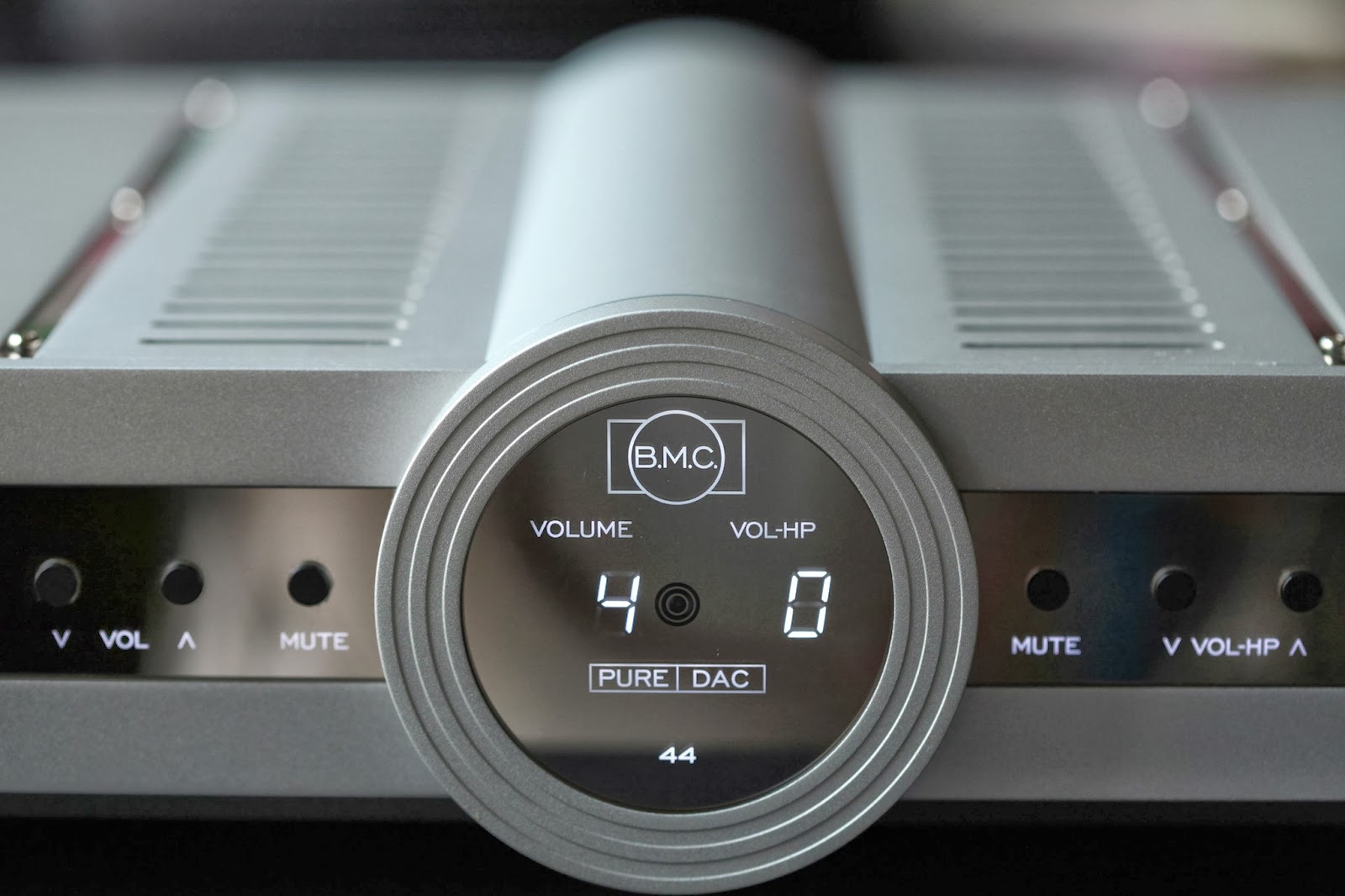
Pure DAC equals Pure Pleasure
 I first heard of Juan Carlos Candeias through his design work with CEC with concepts such as load-effect free (LEF) technology and current injection. I used to own a CEC TL-51XR belt drive CD player which sadly died.
I first heard of Juan Carlos Candeias through his design work with CEC with concepts such as load-effect free (LEF) technology and current injection. I used to own a CEC TL-51XR belt drive CD player which sadly died.
B.M.C. Audio has enjoyed increased visibility locally with the launch of a number of new products over the last year or so. When the PureDAC was announced, there was a certain degree of buzz, with its DSD capability at what was then considered a very affordable price tag. When the product was finally launched some months ago, a number of low cost DSD capable DACs were already in the market, many at a lower price tag than the B.M.C.
Nonetheless, the B.M.C. was intriguing, and I managed to get hold of an almost new unit pre-owned, in a local transaction.
Here are some pictures to whet your appetite. This unit is absolutely stunning in the flesh. Some may find its styling strange – I find it very attractive, and a welcome departure from the usual black box. I unboxed the unit and placed it on a dining table. The girls eyed the unit suspiciously. My wife thought that the central tunnel looked like a telescope. My daughter did not seem impressed. They offered some niceties and went back to doing their own thing. Oh well, I suppose it is a matter of taste.
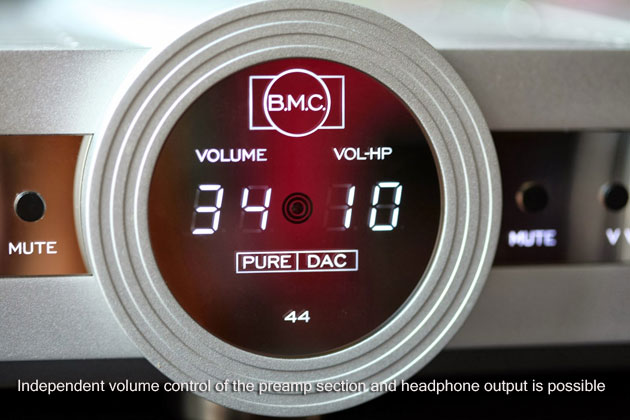
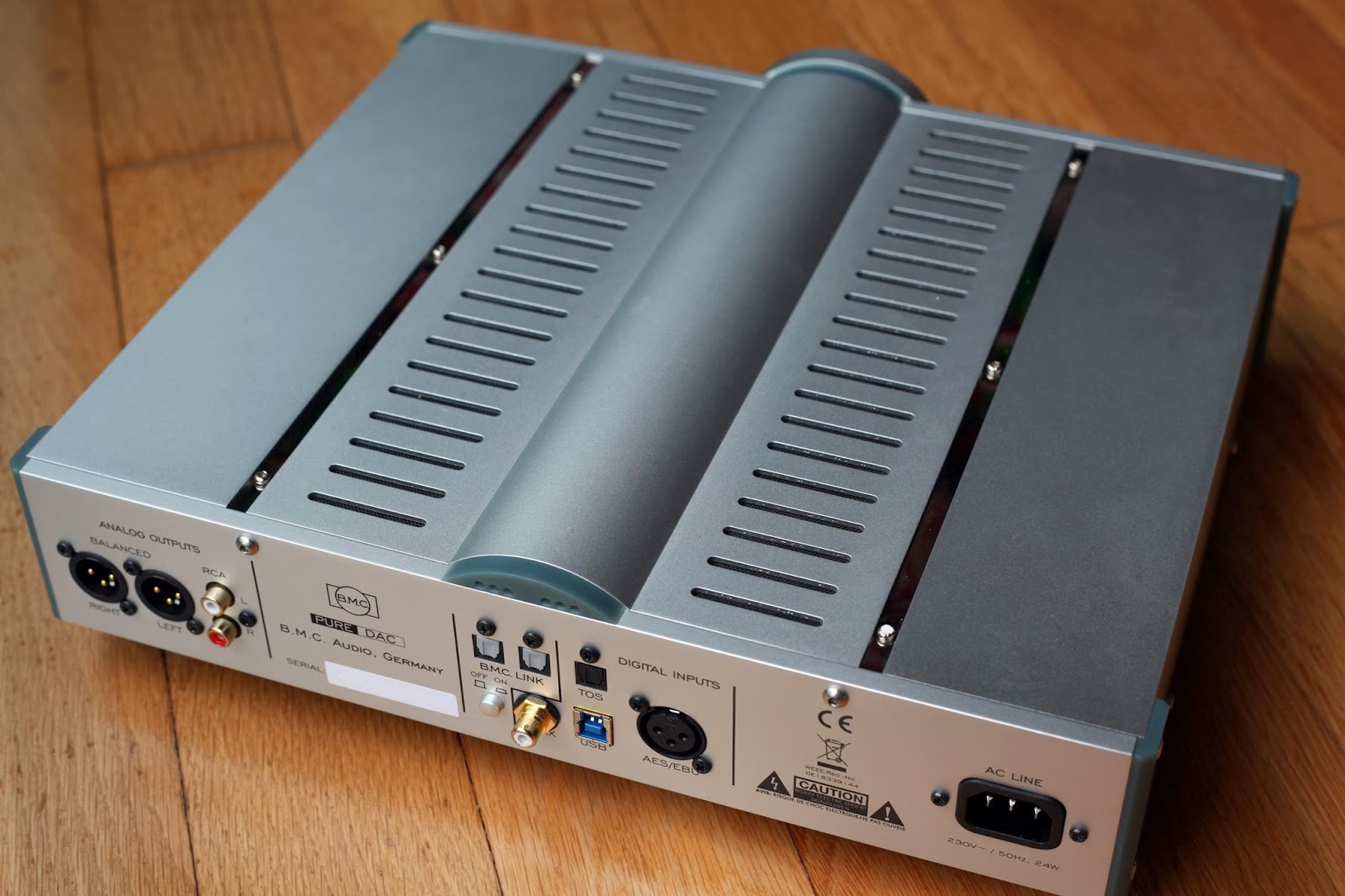
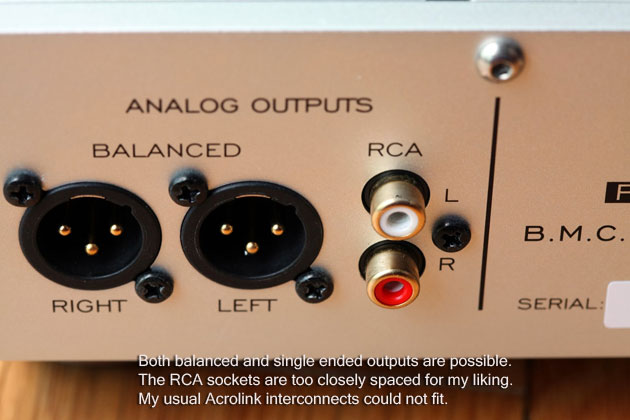
Features
This DAC is equipped with almost anything you could ask for – asynchronous USB that supports up to 24 bit / 384 kHz sampling rate, DSD64 and DSD 128 capability, 4 pin XLR balanced headphone outputs as well as a single ended headphone output via a 1/4 inch stereo jack.
The headphone stage is definitely not an afterthought, being able to deliver up to 1.7 W of power into 100 ohms, more than powerful enough to drive most cans on the market, especially the planar magnetic models which are currently popular. However, do note that the current is limited by a protective circuit to 200 ma for safety purposes for low impedance phones. The balanced headphone output is a low impedance design while the single ended headphone output has a higher nominal output impedance of 100 ohms.
Digital inputs include 1 x Toslink, 1 x coaxial (RCA), 1 x USB and 1 x AES/EBU. I personally prefer BNC to RCA, but the latter is far more common in consumer grade hardware. Analog output is available via both RCA and XLR. The coaxial jack on my unit is different from the official pictures on B.M.C.’s website, which show a recessed RCA jack. Bear this in mind when using your cable of choice. Neither an Acrolink D-5000 nor Acrolink A-2080 RCA cable were able to fit the analog output jacks as they were too closely spaced together for the large diameter plugs used by Acrolink.
Note also that the coaxial, Toslink and AES/EBU inputs support a maximum sampling rate of 96kHz.
A slim but rather flimsy plastic remote control is also provided, which allows control of the preamp output, headphone stage, mute for both and choice of input. Switching off the unit resets the volume to a level of 10 (59 is said to be standard output voltage, presumably, 2V). Depending on how you look at it, this is either annoying (you will need to increase the volume back to your usual level), or prudent (just in case you forgot to decrease the volume after use). In any case, it is a lot safer than my Antelope Zodiac Gold that resets to full output when power is cut.
The two grey Toslink sockets are for use only with compatible B.M.C amplifiers or active speakers, which activate D.I.G.M. (Digital Intelligent Gain Management), controlling volume by setting gain directly at the amplifier, instead of using a resistive network. D.I.G.M. is also used in the PureDAC, which allows very high quality volume control. I prefer this to digital volume control which introduce problems of bit reduction at high attenuation levels. Throw in a power amp, and you are in business if the PureDAC is your only source.
The front central display shows useful information such as the volume setting of both the analog output and headphone stage, as well as sampling rate, and DSD operation.
The Pure DAC is well finished and sturdily built, with a total weight of 5.4 kg.
Sound Quality
The PureDAC was placed in my system rack, where my Calyx Femto DAC usually resides. Power was fed through an Acrolink Mexcel 7N-7500 power cord. Due to the issues with my Acrolink cables, I used a pair of Nordost Frey RCA interconnects instead. USB connection was made via a Wireworld Platinum cable, and my Cary CD-500 was hooked up to the PureDAC’s coaxial input via an Oyaide DR-510 cable. The PureDAC benefits greatly from footers, and it sounded substantially better with a trio of Finite Element Ceraballs, which remained in place throughout the review period.
Despite the unit being well run-in, the PureDAC was disappointingly vague and confused in it’s first few minutes of operation from cold, before blossoming after about half an hour. Do not audition this DAC from cold ! Left continuously switched on, the PureDAC became slightly warm to the touch.
Once in the mood, the PureDAC puts out a pleasant performance. Bass has good extension and slam although both the Calyx Femto and Antelope Zodiac Gold have more impactful and dynamic bass lines. This is most noticeable on kick-drum lines and the tympani in orchestral works which show restraint in the last degree of extension. I also noticed that the left hand on Piano is less impactful compared to my reference equipment.
The midrange has a slight honeyed glow and density to it, imparting a subtle sweetness and added body to voices. Female vocalists have a mildy chestier tone. There was a tendency to downplay sibilance with a smoothening of subtle vocal inflexions. The trade-off is very slight, and does not detract from the original enjoyment of the PureDAC.
High frequencies are clean, with good rendering of decay and space. However, the Calyx Femto still has the PureDAC licked when it comes to three dimensionality, soundstage depth and high frequency extension. The Femto DAC has the uncanny ability to resolve instrument decay and ambience detail to a level which the PureDAC is unable to reach. Given that the Femto DAC is more than three times the price of the PureDAC, lacks a headphone section, and lacks DSD support, this is quite forgiveable and to a large extent, expected.
Between the USB and coaxial input, the latter is weightier sounding, with a slightly bigger image size and better attack but coarser detail. I would not rate either input as being superior to the other, they just sound different. Out of curiosity, I tried increasing the upsampling of the Cary to 192 kHz (the upsampling applies to the digital output too) . The signal initially locked on fine but proved unreliable in the long run. So, you can take B.M.C.’s claimed sampling rate limitation for the non-USB inputs seriously.
After becoming acclimatised to the PureDAC, it was quite enjoyable. Moving from the Calyx 24/192 to the Femto DAC on the other hand, and backwards again, was devestating. Although I have not had the 24/192 in my system for some time now, I can safely say that the PureDAC outperforms it and offers better value with a richer feature set at a similar price tag.
I tried the headphone section through a pair of Beyer DT-880 250 ohm cans, using the single ended output – B.M.C. was not joking when they said in the manual, “Note : This is not the recommended headphone operation mode for the PureDAC.” If you are thinking of buying the PureDAC for single ended headphone duties, one word – don’t. Not, unless you are tasking amplification duties to a dedicated headamp. My Beyer sounded flat and veiled compared to being driven by my DIY Pimeta or Schitt Lyr headamps. The seller let me test the PureDAC through his Audeze LCD2.2 using balanced headphone drive – it was quite good ! Inspired, I built a balanced headphone cable for my Audeze. My Audeze LCD 2.1 is darker sounding than the 2.2 and this was not really an ideal partner for the PureDAC. Tonal matching aside, the balanced headphone section had far greater bass control, gutsiness and transparency compared to the single ended output. The PureDAC had enough current and voltage to drive the Audeze to ear splitting levels. The Head-Fi crowd will definitely give a nod to B.M.C. for their efforts here.
The PureDAC worked quite fine as a preamp, connected directly to my Conrad Johnson power amp. In fact it worked more than fine. I also tried hooking the PureDAC directly to a Job 225 solid state power amp. The combination cost less than S$ 5,000 and was doing a wonderful job powering my Focal Diablo Utopia speakers. I did prefer routing the signal through my Conrad Johnson ET3 SE preamp for additional tonal density, bloom and air – but the difference was not as much as I would have expected. This is definitely a god-send for audiophiles on tight budgets.
How does the PureDAC perform on DSD ? Despite a hair tearing evening, I could not get Pure Music (Version 1.89 running on OS/X Mavericks) to co-operate with the PureDAC. Then again, I had no luck either on a Resonessence Herus DAC I had on loan from a dealer. I knew both units had no issues, as the Herus worked fine with DSD on my PC using Foobar, while I listened to the seller’s DSD files at his place, using JRMC for PC. Repeated tries just resulted in a solitary click followed by silence.
Strangely, I tried the PureDAC again on another Mac computer running on OS/X Mountain Lion in the house and the same DSD files worked fine on both Pure Music (Version 1.88) and Audirvana Plus (Version 1.5.12). Go figure ! For what it is worth, DSD files downloaded from Blue Coast Records were clearly superior to their PCM counterparts. The sympathetic computer was too far from my main system, and hence I could only do quick comparisons using headphones.
Conclusion
The PureDAC deviates slightly from neutral with a sweet and richer midrange presentation. It has good bass and treble. Soundstaging, imaging and resolution were above average in absolute terms. In context of its asking price, the PureDAC has outstanding performance and it’s shortcomings are only obvious when directly compared to the much more expensive equipment I had on hand. Evaluated in isolation, it is immensely likable.
Consider also that the PureDAC is not just a DAC – it is a capable preamp and balanced headphone amp. De-clutter your system by removing two additional boxes, two power cords, two interconnects, and two shelves ! Add a modest price tag (S$ 2,200 in Singapore) to that, and you have an absolute winner.

Price: $1700.00 USA
Features:
-
Top-grade Digital/Analog Converter with Current Injection current-to-voltage (I/V) conversion
-
High-resolution asynchronous USB interface up to 24bit/384kHz
-
USB PCM: 16…32bit; 44.1, 48, 88.2, 96, 176.4, 192, 352.8, 384kHz.
-
USB DSD: DSD64, DSD128.
-
ASIO driver for Windows; Linux and Mac compatible
-
AES/EBU, coaxial and Toslink digital inputs
-
Balanced, reference-class headphone amplifier with digital/analog power convertion (DAPC), load-effect free (LEF) technology, a lateral MOSFET, a super-low impedance LEF output stage, and lossless Digital Intelligent Gain Management (DIGM) volume control
-
Balanced LEF, CI-compatible preamp that optionally operates in B.M.C. Mode, with DIGM and a vertically diffused metal oxide semiconductor (DMOS) and LEF-balanced output stage.
-
Separate volume controls for the line and headphone sections (the line volume position 59 represents a DAC standard output level)
-
Second-generation DIGM with optimized gain distribution between power amps and internal and DIGM volume levels
-
Optical B.M.C. Link for connecting with B.M.C. amps like the PureMono
-
Remote Control
-
Massive and stylish extruded aluminum chassis
-
Dimensions: 14.37 x 4.06 x 12.91 inches, W/H/D (365 x 103 x 328 mm)
- Weight: 11.9 lbs (5.4 kg)
USA Importer:
Aaudio Imports
Stereo Times Masthead
Publisher/Founder
Clement Perry
Editor
Dave Thomas
Senior Editors
Frank Alles, Mike Girardi, Russell Lichter, Terry London, Moreno Mitchell, Paul Szabady, Bill Wells, Mike Wright, and Stephen Yan,
Current Contributors
David Abramson, Tim Barrall, Dave Allison, Ron Cook, Lewis Dardick, John Hoffman, Dan Secula, Don Shaulis, Greg Simmons, Eric Teh, Greg Voth, Richard Willie, Ed Van Winkle, Rob Dockery, Richard Doran, and Daveed Turek
Site Management Clement Perry
Ad Designer: Martin Perry


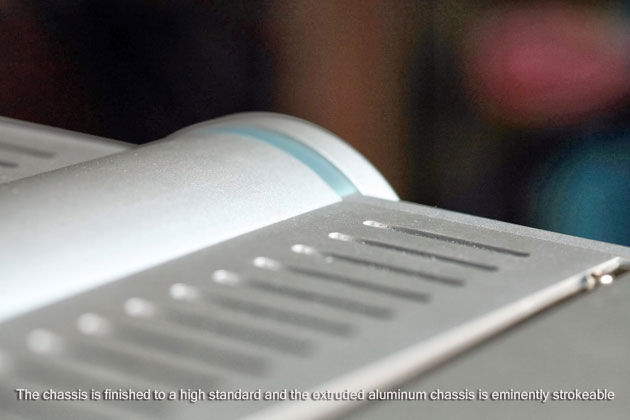




Be the first to comment on: B.M.C. Audio PureDAC1